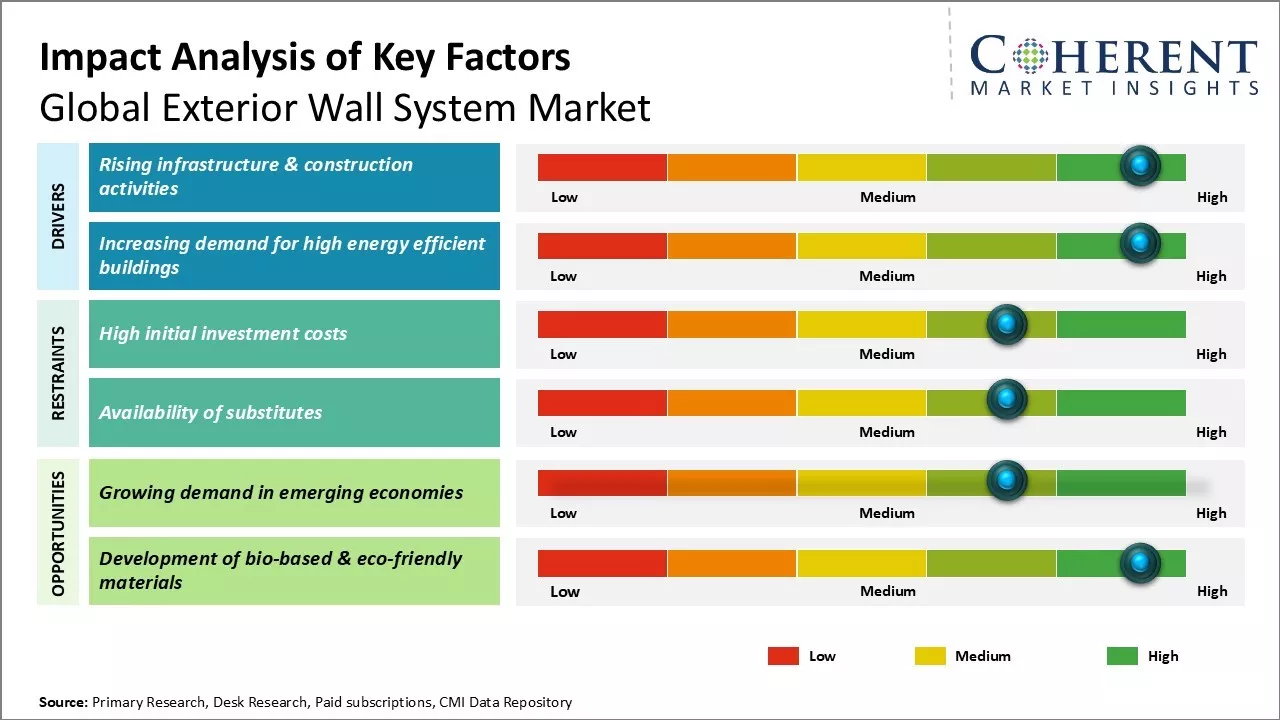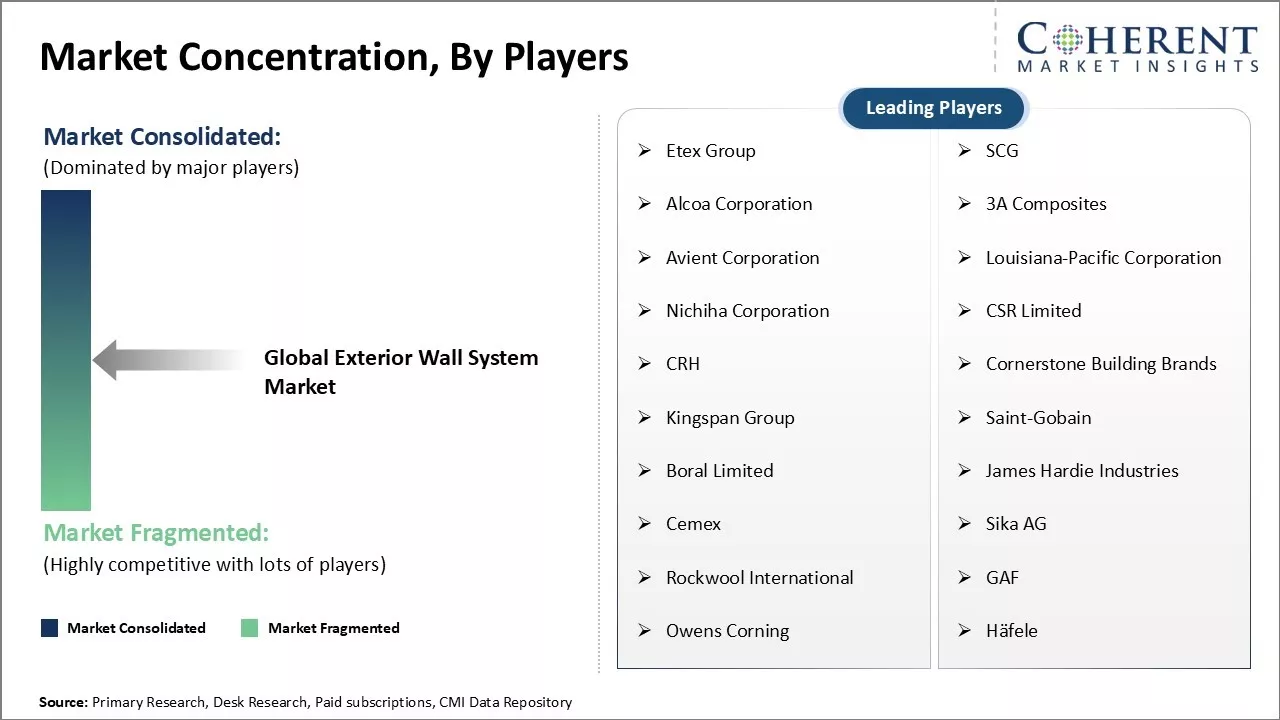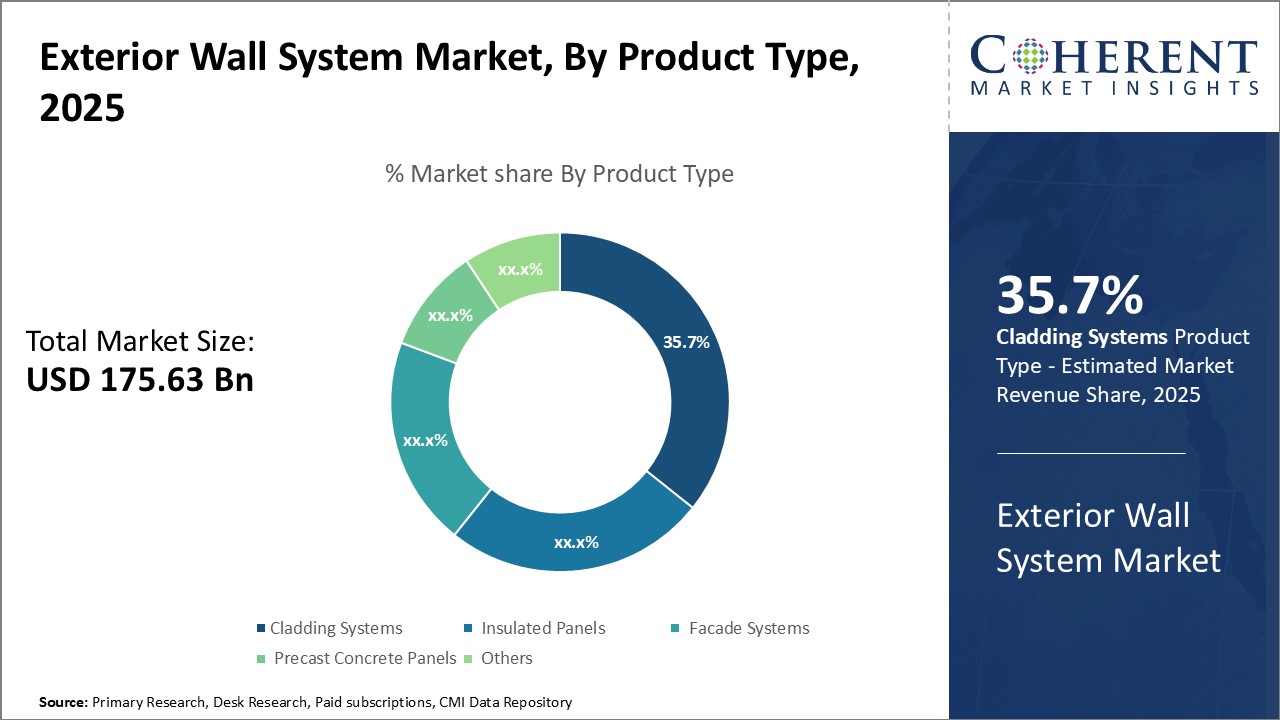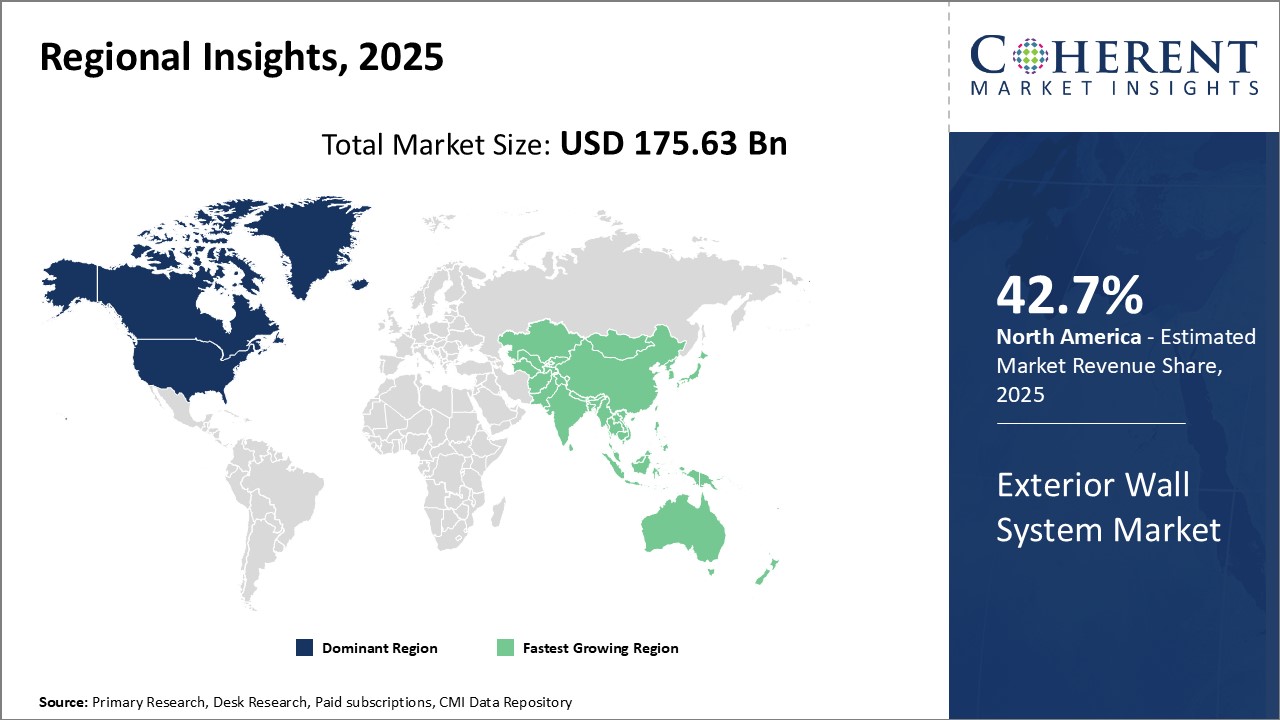Exterior Wall System Market Size and Trends
The global exterior wall system market is estimated to be valued at USD 175.63 Bn in 2025 and is expected to reach USD 297.32 Bn by 2032, exhibiting a compound annual growth rate (CAGR) of 7.8% from 2025 to 2032.

Discover market dynamics shaping the industry: Download Free Sample
The exterior wall system market is witnessing positive trends with construction activities picking up pace globally. Focus on energy-efficient and sustainable buildings is driving the demand for advanced insulation and durable cladding materials in exterior wall systems. Stringent regulatory norms regarding thermal insulation and air infiltration are also propelling manufacturers to introduce innovative solutions to meet building codes. Meanwhile, growth in renovation and refurbishment projects for old buildings provides opportunities for market players. However, fluctuating raw material prices remain a key challenge. Nonetheless, initiatives towards green construction and rising investment in the non-residential construction sector are expected to drive the market growth.
Market Driver - Rising infrastructure & construction activities
With rapid urbanization taking place worldwide, the need for more residential and commercial infrastructure has increased tremendously. Countries across the world are investing heavily in infrastructure development to accommodate the growing population in cities and meet their needs. Mega construction projects ranging from roads and bridges to metro lines, airports and power plants are coming up at a massive scale. This is significantly driving the demand for various construction materials including exterior wall systems.
Developing economies in Asia Pacific, Latin America, Middle East, and Africa that are experiencing high economic growth rates are the major boosters of infrastructure spending. These regions mainly China, India, Indonesia, Brazil, and Saudi Arabia are pouring billions of dollars every year in building new cities, expanding existing ones, and upgrading old infrastructure. Not only does this fuel the real estate and construction industries in these countries but also pushes up exterior wall system usage. Even developed nations of Europe and North America are investing substantial amounts to repair, renovate, and modernize aging buildings, bridges, water supply lines, etc., thus augmenting wall system requirements.
The building construction market worldwide especially the residential and commercial sectors have picked up quite well post the 2008 recession. Rising incomes, availability of housing loans at lower interest rates, emergence of nuclear family structures and urban migration are some factors driving more building activity. Furthermore, governments across are keen on real estate and construction as they provide large scale employment opportunities and their multiplier effect boosts economic growth. This positive construction environment keeps market for all associated building materials including exterior wall systems thriving. With building space needs seeing consistent rise on back of population expansion and higher disposable budgets, demand for efficient construction solutions like prefabricated wall panels is likely to increase significantly in the coming years.
Market Concentration and Competitive Landscape

Get actionable strategies to beat competition: Download Free Sample
Increasing demand for high energy efficient buildings
Due to growing environmental concerns as well as the need to reduce operational costs of buildings, there is a massive surge in demand for green and sustainable construction globally. Buildings today consume around 40% of the total energy globally and are also responsible for nearly 38% of total carbon dioxide emissions. This has necessitated measures to improve building designs and materials that provide better insulation against heat and cold thus lowering energy consumption for heating and cooling. Energy efficient buildings not only cut carbon footprint but also results in huge savings on electricity bills for owners and tenants leading to faster returns on investment.
Stringent new building codes and regulations in countries across regions have elevated the importance of thermal insulation and weather proofing building components. This has opened up opportunities for manufacturers of next generation high performance exterior wall systems. These insulated metal panels, rainscreen panels, and polymeric foam insulated panels offer unmatched thermal resistance along with moisture resistance, durability and longevity over normal wall materials. Particularly for large commercial buildings like offices, malls, hospitals, data centers and industrial units located in regions with hot, cold or wet climates, the operational cost benefits of such premium wall systems are very high.
Additionally, a growing section of discerning home buyers and commercial real estate investors are willing to pay extra for buildings certified as energy star or green rated. This has made sustainable features like energy efficient wall panels extremely sought after in new residential and non-residential construction projects. Developers are also adopting them widely to gain competitive differentiation and access more buyers. With strict norms anticipated on building energy performance, the need for wall materials that enhance energy efficiency is rising rapidly and remains a strong growth driver for the global exterior wall system market in the coming decade.
Key Takeaways from Analyst:
The global exterior wall system market is expected to witness stable growth over the next decade driven by rising construction of commercial buildings and infrastructure development projects across major economies. Governments are increasingly spending on public infrastructure like roads, bridges, hospitals, and schools which utilize exterior wall systems. Further, tighter building codes regarding energy efficiency are propelling the use of advanced insulated panels and green building materials in wall systems.
However, raw material price volatility remains a key challenge. Fluctuations in prices of cement, concrete, and metals impact installed costs of exterior wall projects. Availability of skilled labor is another bottleneck, especially in developing markets. The market also faces obstacles around design flexibility as modular or pre-fabricated systems allow less customization than traditional construction methods.
On the brighter side, new product innovations are expanding opportunities. Lightweight and high strength wall panels are gaining traction due to ease of installation. Popularity of rainscreen principles for commercial building envelopes is opening an avenue for specialized rainscreen systems. Integrated photovoltaic and solar panels are being increasingly used on walls to harness renewable energy. Geographically, the Asia Pacific region led by China and India will likely witness the strongest growth in demand amid rapid infrastructure modernization. Sustained construction spending will also drive the market.
Market Challenge - High initial investment costs
One of the key challenges for the global exterior wall system market is the high initial investment costs associated with exterior wall systems. Developing and installing these systems requires significant upfront capital expenditure which can be a barrier for construction companies and building owners. Exterior wall systems involve use of advanced materials like glass, metal panels, composite panels etc., which are generally more expensive than traditional construction materials. The assembly and installation of these complex facades also involves specialized labor that increases project costs. Further, maintenance of modern exterior wall systems in the long run also demands continuous capital investment. The high initial costs make exterior wall systems unsuitable for low budget construction projects and affordable housing segments. For widespread adoption of innovative wall system technologies, lowering the capital expenditure remains a major challenge for manufacturers and solution providers.
Market Opportunity - Growing demand in emerging economies
One of the major opportunities for the global exterior wall system market is the growing demand in emerging economies. With rapid urbanization and infrastructure development projects, many developing nations in Asia Pacific, Middle East, Africa and Latin America are witnessing a massive rise in construction activities. There is a huge housing shortage and the need for commercial buildings, malls, offices etc., in these emerging markets. This presents a large untapped market potential for exterior wall system providers. As the economies grow and construction budgets increase, the adoption of advanced wall facades will also see an upsurge. The aesthetic appeal and design flexibility offered by modern exterior wall solutions would appeal to the developing nations. By offering customized and cost-effective products, wall system manufacturers can tap into this vast opportunity arising from infrastructure growth in emerging markets across the globe.

Discover high revenue pocket segments and roadmap to it: Download Free Sample
Insight by product type: Customer Preference Shapes Product Dominance
In terms of product type, the cladding systems segment is estimated to dominate the market revenue share with 35.7% in 2025, owing to their widespread acceptance and versatility. Cladding offers an aesthetic and protective finish to facades, is low maintenance, and comes in a wide variety of styles and materials to suit different architectural needs. Their installation is also relatively simple compared to other complex exterior wall systems. This has made cladding a top choice for both residential and commercial projects. Properties like durability against various climatic conditions while retaining an attractive look have made cladding systems many builders and designers' default option. Their ability to mimic other materials like natural stone through composites has further increased popularity. As more constructions move towards minimal designs accentuating exteriors, cladding is poised to retain its dominance in the product type segment.
Insights by material: Adaptable Design Drives Material Dominance
In terms of material, the metal segment is estimated to contribute 35% share of the market in 2025, owing to its versatile design applications. Metal exterior walls allow creative expression through unique patterns, textures, and geometric forms. Their malleability allows emulating different aesthetics through composite metal panels assembled in interesting configurations. Steel in particular is a highly sustainable and low maintenance choice. Its corrosion resistance properties have increased usage in tougher environments like coastal regions. Metal exteriors are also lightweight and require simple assembly methods. This has made installation easier on constructions with tight schedules. As architectural ideas explore bold, futuristic designs, metal remains the material of choice for its inherent flexibility to reproduce modern, visually arresting facades.
Insights by application: Housing Sector Steers Application
In terms of application, the residential segment is estimated to contribute 33.7% share of the market in 2025, as it forms the largest end-use for exterior wall systems. Stable growth in the global housing sector driven by urbanization continues to drive robust residential construction worldwide. This fuels consistent demand for external wall solutions to provide strength, aesthetics and weather protection for homes. As the world's population reside increasingly in cities, more apartment complexes and gated communities are being developed requiring extensive walling systems. Since appearance and curb appeal hold significance for residential properties, builders prefer superior exterior finishes to attract buyers. This makes walling an important investment area. As housing construction maintains its momentum, residential applications will remain the frontrunner in the exterior wall system market.
Regional Insights

Need a Different Region or Segment? Download Free Sample
North America has been dominating the global exterior wall system market for a long time. The region is expected to hold 42.7% of the market share in 2025, owing to a well-established construction industry and the presence of major players in the region. The U.S. accounts for the largest share within the region primarily due to the increasing construction of commercial buildings over the years. Various states have implemented strict building codes regarding the energy-efficiency of building envelopes that uses products like insulated metal panels, EIFS, and stucco among others. This has spurred the demand for such advanced exterior wall systems from contractors. Moreover, home owners are increasingly opting for these premium solutions to reduce heating and cooling bills over the lifespan of properties.
The Asia Pacific exterior wall system market has emerged as the fastest growing regional market driven by ongoing infrastructural development activities, rapid urbanization and rising disposable incomes. China alone contributes more than half of the total regional demand led by staggering investments in new construction projects related to transportation, airport terminals, SEZs, and hospitality sector. Both domestic as well as international brands have set up their manufacturing hubs in China to serve the colossal requirement. In India, government initiatives such as ‘housing for all’ and ‘smart cities’ mission coupled with expanding real estate and construction industries have augmented the exterior wall system sales volume significantly in India. Notable industry participants in the market maintain stringent quality standards and offer extensive design consulting services to architectural firms. This allows them to charge premium pricing for their solution portfolio compared to other regions. On the other hand, pricing in Asia Pacific remains economical owing to low labor and material costs, which entices many global players to outsource their production facilities to China and other Southeast Asian countries. Robust construction spending in Asia Pacific is attracting several foreign companies to establish local manufacturing presence through joint ventures with regional players or by green-field projects. This will intensify the competition while forcing local suppliers to upgrade their product offering.
Market Report Scope
Exterior Wall System Market Report Coverage
| Report Coverage | Details | ||
|---|---|---|---|
| Base Year: | 2024 | Market Size in 2025: | USD 175.63 Bn |
| Historical Data for: | 2020 To 2024 | Forecast Period: | 2025 To 2032 |
| Forecast Period 2025 to 2032 CAGR: | 7.8% | 2032 Value Projection: | USD 297.32 Bn |
| Geographies covered: |
|
||
| Segments covered: |
|
||
| Companies covered: |
Etex Group, SCG, Alcoa Corporation, 3A Composites, Avient Corporation, Louisiana-Pacific Corporation, Nichiha Corporation, CSR Limited, CRH, Cornerstone Building Brands, Kingspan Group, Saint-Gobain, Boral Limited, James Hardie Industries, Cemex, Sika AG, Rockwool International, GAF, Owens Corning, and Häfele |
||
| Growth Drivers: |
|
||
| Restraints & Challenges: |
|
||
Uncover macros and micros vetted on 75+ parameters: Get instant access to report
Exterior Wall System Industry News
- In November 2020, Etex-Arauco, a joint venture focused on end-to-end (E2E) construction solutions, announced its agreement to acquire a majority share in Tecverde, a company renowned for its innovative wood-frame construction techniques. This strategic acquisition is set to enhance Etex-Arauco's capabilities in the Brazilian construction market, allowing for the fabrication of entire structures using advanced wood-frame technology.
- In September 2020, Alcoa Corporation an industrial corporationannounced the launch of EcoSource, a groundbreaking addition to its Sustana product portfolio. EcoSource is recognized as the industry's first low-carbon, smelter-grade alumina brand, reflecting Alcoa's commitment to sustainability and reducing carbon emissions in the aluminum production process.
*Definition: The global exterior wall system market includes various types of wall finishes, coverings, supports and accessories that form the external walls of residential and commercial buildings. Some key elements of exterior wall systems include rainscreen panels, exterior insulation and finish systems, aluminum or steel framing, exterior architectural panels, and ventilated facade systems. The global market provides products and solutions for wall cladding, insulation, weather resistance, durability, and aesthetic appearance of a building's exterior.
Market Segmentation
- Product Type Insights (Revenue, USD Bn, 2020 - 2032)
-
- Cladding Systems
- Insulated Panels
- Facade Systems
- Precast Concrete Panels
- Others
- Material Insights (Revenue, USD Bn, 2020 - 2032)
-
- Metal
- Wood
- Vinyl
- Brick and Masonry
- Others
- Application Insights (Revenue, USD Bn, 2020 - 2032)
-
- Residential
- Commercial
- Industrial
- Institutional
- Regional Insights (Revenue, USD Bn 2020 - 2032)
- North America
- U.S.
- Canada
- Latin America
- Brazil
- Argentina
- Mexico
- Rest of Latin America
- Europe
- Germany
- U.K.
- Spain
- France
- Italy
- Russia
- Rest of Europe
- Asia Pacific
- China
- India
- Japan
- Australia
- South Korea
- ASEAN
- Rest of Asia Pacific
- Middle East
- GCC Countries
- Israel
- Rest of Middle East
- Africa
- South Africa
- North Africa
- Central Africa
- North America
- Key Players Insights
- Etex Group
- SCG
- Alcoa Corporation
- 3A Composites
- Avient Corporation
- Louisiana-Pacific Corporation
- Nichiha Corporation
- CSR Limited
- CRH
- Cornerstone Building Brands
- Kingspan Group
- Saint-Gobain
- Boral Limited
- James Hardie Industries
- Cemex
- Sika AG
- Rockwool International
- GAF
- Owens Corning
- Häfele
Share
Share
About Author
Ramprasad Bhute is a Senior Research Consultant with over 6 years of experience in market research and business consulting. He manages consulting and market research projects centered on go-to-market strategy, opportunity analysis, competitive landscape, and market size estimation and forecasting. He also advises clients on identifying and targeting absolute opportunities to penetrate untapped markets.
Missing comfort of reading report in your local language? Find your preferred language :
Transform your Strategy with Exclusive Trending Reports :
Frequently Asked Questions
EXISTING CLIENTELE
Joining thousands of companies around the world committed to making the Excellent Business Solutions.
View All Our Clients
